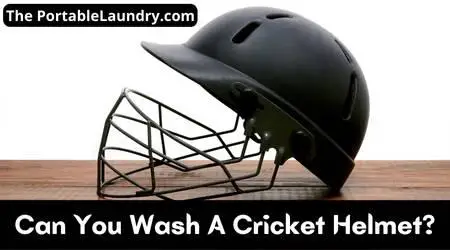As a cricketer, you know that a helmet is one of the most important safety gear you have in your kit bag.
Not only does it protect against a head injury but it also keeps you cool in the hot sun.
Since you wear a helmet almost all the time until you bat, it’s important that you keep it clean and hygienic to prevent any infections.
A Cricket helmet should never be soaked in water in order to wash them. Instead, it’s always good to spot clean the stains and dirty areas with mild soap or vinegar.
In this article, you will learn exactly how to wash a cricket helmet safely.
What is a cricket helmet?
A cricket helmet is worn by a cricket player to protect their head from injuries during the match.
They are designed specifically to stop severe injuries from occurring when a cricket ball strikes a player in the head.
These helmets are usually worn by a batsman, a wicketkeeper or a player positioned close to the batter in the cricket outfield.
What are the cricket helmets made of?
The material used to make a cricket helmet may vary depending on the manufacturer.
In General, to make a cricket helmet sturdy and strong enough to resist impact, materials such as ABS plastic, fiberglass, carbon fiber, titanium, steel, and high-density foam are used.
The cricket helmet is usually made up of hard plastic or a metal shell with a foam lining.
The foam padding inside the helmet helps to protect the head from major impacts.
It also includes cushioning on the inner surface.
The helmet also includes a faceguard in the form of a grill which is usually made of metal.
The grill protects the cricketer’s face from getting hit by the hard leather ball.

To hold on to the head, there are straps usually made of nylon or another type of strong synthetic material.
These straps are adjustable so that the helmet can fit snugly to the head and maintain its balance.
Why you should regularly clean your cricket helmet?
Overtime helmets can harbor harmful bacteria and fungus.
This is due to the mixture of sweat and dust accumulated around its surface. Hence it is important to wash your cricket helmet on a regular basis.
Washing your helmet regularly can help keep you safe from bacteria and fungus and extend its life.
A good washing will remove any dirt, dust, or grime that has built up on the surface of your helmet.
This will help to keep the helmet looking new and prevent any premature wear and tear.
How to wash a cricketer’s helmet?
In order to wash a cricketer’s helmet, you will need a few items.
Let’s take a quick look at the items required for washing a helmet followed by basic pre-requisites.
What you will need
- A cleaning cloth
- Mild soap OR Detergent
- Water
- Vinegar (optional)
Pre-Requisites
A few cricket helmets have removable elements such as the face grill guard, internal paddings, and a lining.
For better wash results you may carefully remove them and treat them separately.
The face grill guard can be removed by unscrewing a couple of screws from either side.
Helmets have a release catch at the back which allows you to take the face guard off.
Once that’s off, you can give it a good clean with soapy water and a soft cloth.
If there are any stubborn marks, you can use a mild abrasive like white vinegar or Baking Soda.
Instructions to Wash Cricketer’s Helmet Safely
Step 1: Read the Care Label
The first step should be to read the care label carefully.
If the care label discourages washing the helmet by soaking it in water, then it’s best to stick to that advice and follow the spot-cleaning process.
Step 2: Remove Excess Dirt and Dust
Using a soft brush remove excess dust from the surface of the helmet with gentle scrubbing.
Step 3: Prepare a Cleaning Solution
Mix a solution of water with a mild soap or detergent in a bowl.
Do not use anything too harsh, as it could damage the helmet.
Step 3: Spot Clean the Helmet
Dip a sponge or a cloth into the soapy water and apply it to the surface of the helmet thoroughly.
Be sure to pay extra attention to the areas around the vents, as this is where dirt and grime tend to build up the most.
Next, gently scrub the surface and leave the solution for a few minutes.
Note: If the care label recommends spot cleaning, this should be the final step. All you need to do is wipe the helmet with a dry soft cloth. For sanitizing you may use wipes.
Step 4: Prepare for Hand-Wash
Now fill a bucket with warm water and add a mild detergent.
Step 5: Dip the Helmet
Dip the helmet and the detached parts in the bucket and leave it to settle for around 10 minutes.
Step 6: Work on the Helmet
Start working on the helmet to get rid of dirt and stains.
Step 7: Rinse the Helmet
Rinse the helmet under clean water thoroughly so that detergent residues are eliminated.
Step 8: Wipe the Helmet
Wipe off the entire helmet with a soft towel and put them for air drying.
Step 9: Assemble the Helmet
Once the helmet is completely dry, re-assemble it. You may polish the helmet with a suitable solution and it will be ready for the next use.
Final Thoughts
Regular cleaning of helmets can ensure that your helmet is clean and bacteria-free and it will also help to last longer.
Most cricket helmets come with manufacturers’ instructions for cleaning, therefore it helps to decide the best cleaning approach i.e. spot-cleaning OR complete handwashing.
Lastly, do not use harsh chemicals or cleaning solutions to clean the helmet. Instead, always make use of mild soap.
You May Also Like
- How to Wash Cricketer’s Batting Gloves?
- Can Curtains be Washed in Washing Machine? (Explained)
- How to Wash a Laptop Bag In Washing Machine? (Step-by-Step)
- How To Wash Saree In Washing Machine? (Ultimate Guide)
- Can you wash bird poop in your washing machine?
- Is it OK to Wash Sneakers in the Washing Machine?
- Is it Better to Wash a Hat in the Dishwasher Or the Washing Machine?
- Is it OK to Wash a Dog Bed in the Washing Machine?
- How to use color catcher sheets? (Step-by-Step)
- 7 Ways to Remove Musty Smell Out Of Clothes
